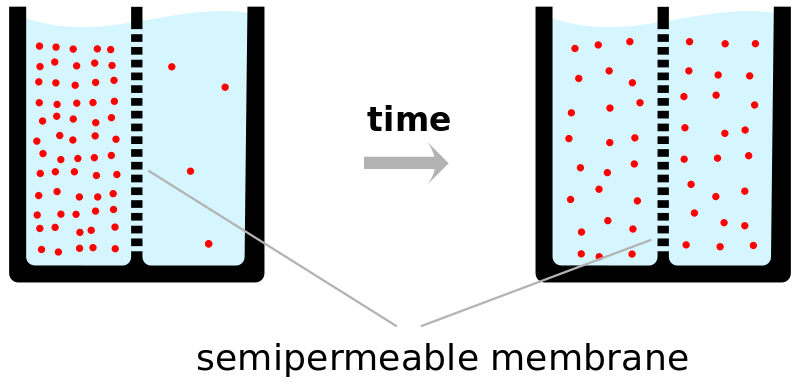Gas Exchange in The Lungs
- Created by: Molly
- Created on: 05-03-13 13:30
The Exchange Surface
The site of gas exchange in MAMMALS is the epithelium of the alveoli. To ensure a constant supply of oxygen to the body, a diffusion gradient must be maintained at the alveolar surface.
Essential Features of Exchange Surfaces
To enable efficient transfer of materials across them by diffusion or active transport, exchange surfaces have the following characteristics:
- They have a large surface area to volume ratio to speed up the RATE OF EXCHANGE.
- They are very thin- to keep the diffusion path way short and so allow materials to cross rapidly.
-They are partially permeable - to allow selected materials to diffuse easily.
-There is movement of the environmental medium, e.g. air - to maintain a diffusion gradient.
- There is movement of the internal medium, e.g. blood - to maintain a diffusion gradient.
Fick's Law
Rate of Diffusion = Surface Are x Difference in Concentration
-------------------------------------------------------
Length of diffusion pathway
Role of the Alveoli in Gas Exchange
Each alviolus is lined mostly with epithlelial cells (very thin). Around each alveolus is a network of pulmonary capillaries, so narrow that red blood cells are flattened against the thin capillary walls in order to squeeze through. The capillaries have walls that are a single cell thick, and so diffusion of gases between the alveoli and the blood are rapid, because:
- Red blood cells are slowed down as they pass through the pulmonary capilaries meaning there is more time for diffusion.
-The distance between the alveolar air and the red blood cells is reduced as the red blood cells are flattened against the walls of the capillaries.
- The walls of both alveoli and capillaries are very thin and therefore the distance over which diffusion takes place is very short.
- Alveoli and pulmonary capillaries have a very large total surface area.
- Breathing movements constantly ventilate the lungs, and the action of the heart constantly circulates the blood around the alveoli. Together, these ensure that a steep concentration gradient of the gases to be exchanged is maintained.
-Blood flow through the capillaries maintains a concentration gradient.
The effects of Smoking on Gas Exchange in The Lung
- Emphysema. Decreased surface area for gas exchange, because the alveoli are broken down. Phagocytes reach tar by making a pathway through the walls of the alveoli.
- Lung cancer. The carcinogenic compounds in tar change the DNA in our airways. They grow and divide in. When they accumulate, it is called a tumour, which may end up growing so large that it blocks the airways and blood vessels.
- Heart disease. Coronary heart disease is caused by nicotine, as large amounts of it increase the chances of blood clots. The heart muscle is damaged by the lack of oxygen.
- Tar causes the lining of the airways to produce extra mucus, due to irritation. The excess mucus will gather together in the airways because the cilia become too damaged to remove the mucus. The phrase "smoker's cough" comes from this syndrome, because smokers cough in order to shift the mucus to the back of the throat
Diffusion
The exchange of substances between cells and the environment occurs in ways that requires metabolic energy (active transport) and in ways that do not require energy (passive transport). DIFFUSION is an example of PASSIVE TRANSPORT.
- All particles are constantly in motion due to the kinetic energy they possess.
- This motion is random, with no set pattern to the way the particles move around.
- Particles are constantly bouncing off one another as well as off other objects, e.g. the sides of the vessel in which they are contained.

Defenition of Diffusion
Diffusion is therefore defined as:
THE NET MOVEMENT OF MOLECULES OR IONS FROM A REGION WHERE THEY ARE MORE HIGHLY CONCENTRATED TO ONE WHERE THE CONCENTRATION IS LOWER.
Rate of diffusion:
There are a number of factors that affect the rate at which molecules or ions diffuse.
- The concentration gradient. The greater the concentration gradient the faster the rate of diffusion.
- Area over which diffusion takes place. The larger the surface area of an exchange surface the faster the rate of diffusion.
- Thickness of exchange surface. The thinner an exchange surface, the faster the rate of diffusion.
Related discussions on The Student Room
- I enjoy chem practicals more than bio practicals. Is a chem degree right for me? »
- Biochemistry Personal Statement Example »
- Biochemistry vs Chemistry vs Natural Sciences »
- Access to Science course »
- Biochemistry at University »
- Alevel bio synoptic essay »
- Grade Growth Chronicles | From C's to A's (23-24) »
- A&P revision recommendations »
- AQA Biology essay »
- AS aqa chem help please asap »
Comments
No comments have yet been made